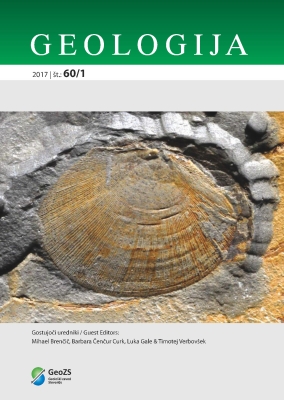Characterization of silicified fossil assemblage from upper Carnian "Amphiclina beds" at Crngrob (central Slovenia)
DOI:
https://doi.org/10.5474/geologija.2017.005Abstract
The village of Crngrob (central Slovenia) is known to geologists for the silicified fossils found in the thick soil covering the "Amphiclina beds", a Carnian lithostratigraphic unit of the Mesozoic Slovenian Basin. Due to silicification, the assemblage may provide an important insight into Carnian marine life; however, the nature of the fossil assemblage, as well as the timing and mode of silicification are unknown. A detailed sedimentological section, which covers the uppermost part of the "Amphiclina beds" and their transition to the "Bača Dolomite", was recorded at one of the fossil-bearing localities. The section consists of limestone (including bioturbated filament and radiolaria-filament wackestones, laminated filament packstone, bioclast wackestone, peloid packstone, floatstone with intraclasts and bioclasts, and intraclast floatstone and rudstone), marlstone and dolomite. Chert is locally present in nodules or as dispersed silicified patches, giving a speckled appearance to the host rock. According to our interpretation, the deposition of the limestone occurred via hemipelagic settling, turbidite currents and debris flows in a slope-to-basin or outer ramp setting. The composition of the grains (which include green algae fragments, thick-shelled bivalves, corals and solenoporacean algae) clearly points to the allochthonous nature of the material, which was largely derived from shallow-water environments. Fossils, as well as the intraclasts and sometimes the matrix, are locally replaced by chalcedony and granular megaquartz. This type of silicification does not appear to be selective to particular microfacies. As the silicification occurred after the down-slope transport of shells and the deposition of the sediment, the Crngrob fossil assemblage represents a thanatocoenosis or even a taphocoenosis, and it is not representative of autochthonous Carnian associations.Downloads
How to Cite
Gale, L., Novak, U., Kolar-Jurkovšek, T., Križnar, M., & Stare, F. (2017). Characterization of silicified fossil assemblage from upper Carnian "Amphiclina beds" at Crngrob (central Slovenia). Geologija, 60(1), 61–75. https://doi.org/10.5474/geologija.2017.005
Issue
Section
Articles

